#Crammond
Explore tagged Tumblr posts
Text






Crammond Mesolithic Site, Crammond, Edinburgh, Scotland
Excavations carried out on this spot in 1995 discovered the remains of what at the time was Scotland's earliest known settlement. The archaeologists discovered stake holes and pits, together with thousands of hazelnut shells and tools made of flint and chert.
The stone tools included arrowheads, scrapers, burins (for punching holes) and small blades for hunting and gathering activities. The stake holes marked the site of tent-like shelters where the people sat making and using these tools and also where they prepared and cooked their food. The pits were filled with the burnt shells of hazelnuts which were an important food source. These shells have been carbon dated to around 10,500 years ago (between 8,630BCE and 8,250BCE). The people who camped here so long ago were amongst the first to discover Scotland after the last Ice Age had ended, less than 1,000 years earlier. It marks the start of the Mesolithic period in Scotland. This lasted until the arrival of farming in the Neolithic period at around 4,000BCE.
Sea levels rose when the last Ice Age ended. This flooded the land (Doggerland) which had joined the south of Britain to the continent. People had to move because of this, some moving north along the coast. These explorers were skilled at gathering all the things they needed to survive from the countryside around them.
We need to imagine how Cramond looked 10,000 years ago. This was a great place to choose for a campsite. The sea and the River Almond offered plenty of food, such as fish and shellfish. The local forest provided other foodstuffs and resources, such as wild animals and birds, nuts, berries and plants, as well as animal skins for clothing and wood for fuel and building.
#ice age#stone age#bronze age#iron age#prehistoric#prehistory#neolithic#mesolithic#paleolithic#archaeology#hunter gatherer#prehistoric site#ancient sites#ancient living#settlement#shelter#community#Scotland#Edinburgh#Crammond
58 notes
·
View notes
Text

2011ish. Crammond
0 notes
Text
Marine Beaufils - La Sentinelle
Marine Beaufils is a French embroidery artist. (...) On embroidery’s matrix, she tries to fit the details of the video games she loves, the vignettes of her favorite movies, the readings that have marked her or the colors of astronomical views that fascinate her.
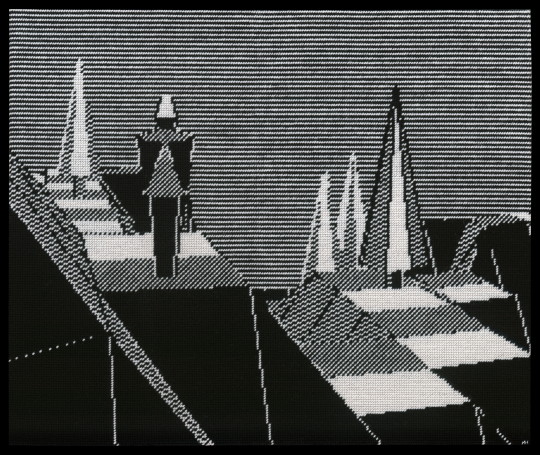
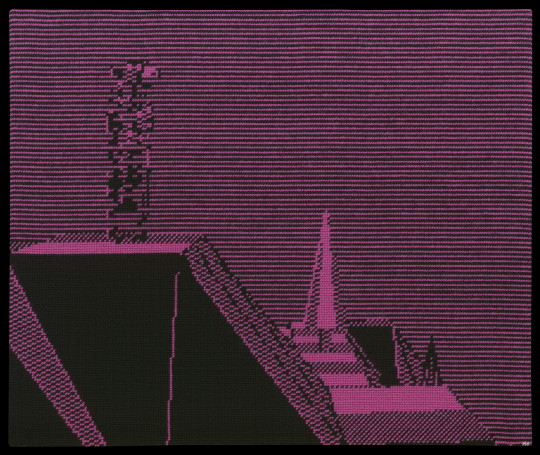
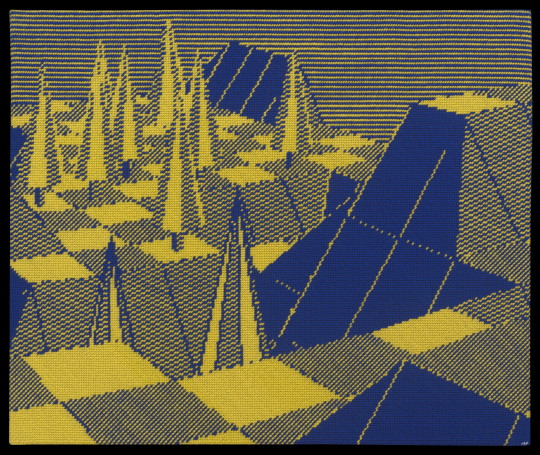
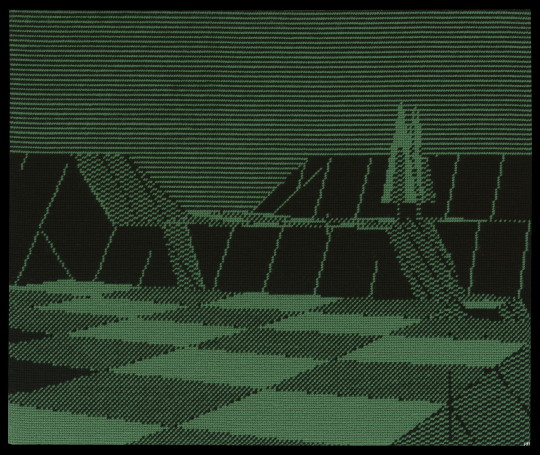
La Sentinelle is a needlepoint project initiated in 2022. (...) Each needlepoint represents a scene from the video game The Sentinel (1986) created by Geoff Crammond—initially for BBC Micro. Each scene is illuminated by a unique color duo from the game’s eight-shade palette, here in the ZX Spectrum version—ported by Mike Follin.
Project page / Shop
4 notes
·
View notes
Video
youtube
Back Cover to AI Art S2E16 - World Circuit
Older video games were notorious for back cover descriptions that have nothing to do with the game so let's see what a text-to-image generator makes of these descriptions. Season 2 sees an increase in art creations for each game up from 1 in the first season to 6 for the second season
1. Intro - 00:00
2. Back Cover and Text Description - 00:10
3. Creation 1 - 00:30
4. Creation 2 - 00:50
5. Creation 3 - 01:10
6. Creation 4 - 01:30
7. Creation 5 - 01:50
8. Creation 6 - 02:10
9. Outro – 02:30
World Circuit known as Formula One Grand Prix outside of the US is the first entry in Geoff Crammond's Grand Prix series of Formula One racing games, a series that had four instalments, running from 1991s World Circuit culminating in 2002s Grand Prix 4. World Circuit was released on the Amiga and Atari ST in 1991 with a DOS release the following year.
Twitter (Gaming & AI Art)
https://twitter.com/zero2zedGaming
Instagram (AI Art)
https://www.instagram.com/random_art_ai/
For more Back Cover to AI Art videos check out these playlists
Season 1 of Back Cover to AI Art
https://www.youtube.com/playlist?list=PLFJOZYl1h1CGhd82prEQGWAVxY3wuQlx3
Season 2 of Back Cover to AI Art
https://www.youtube.com/playlist?list=PLFJOZYl1h1CEdLNgql_n-7b20wZwo_yAD
#youtube#world circuit#geoff crammond#formula 1#grand prix#motorsport#art#ai#ai art#ai artworks#artificial intelligence#digital art#machine learning#generative art#generative ai#aiartcommunity#ai artist#90s games#90s gaming#atari st#amiga#ms-dos#1991
3 notes
·
View notes
Text

Bras d'Or lake August 13, 2022
2 notes
·
View notes
Text





Crammond Kirk
64 notes
·
View notes
Text
american man going to scotland because his ancestors lived there five hundred years ago so OBVIOUSLY this is his sacred homeland and then he ends up fucking stranded on crammond island because he can’t read the dozens of signs saying to watch for high tides and not to travel there alone and then the lifeboat crew have to rescue him 💀💀💀💀 most normal american tourist in scotland
4 notes
·
View notes
Text
One time when I was wee I went down to the beach outside of Edinburgh. I think it was Crammond beach, which is next to a roman town ruin. But I can’t remember exactly. Anyway, I went with my father and my two brothers. And my big brother thought it’d be a cool idea to head out along the straight of the sand, heading north. Whilst we left my father sitting on his blanket. So my father went to sleep on his blanket, whilst we boys walked out for about half an hour along the sand … And when my father woke up, the forth water had swelled up all over the front part of the beach. And he couldn’t see any of us. … It turned out that that particular beach had an irregular tide, whereby the land was sloped in a different manner, so that the water rushed in in different parts of the beach. And so my brothers and I had walked out about a half mile onto the sand – and the water had closed off the area where we had set out from, and was quickly surrounding us from all angles. But, we didn’t know, because it was a sunny day, and it was just like taking a stroll on wet sand. We had no clue how dangerous the situation was until our father came running after us at full pelt. He caught up to us and told us to run, fast, back to the coast. … It was really weird. All three of us might’ve drowned. I probably would have – as I’ve always been a shit swimmer.
1 note
·
View note
Link
0 notes
Text
En persecución de los balleneros
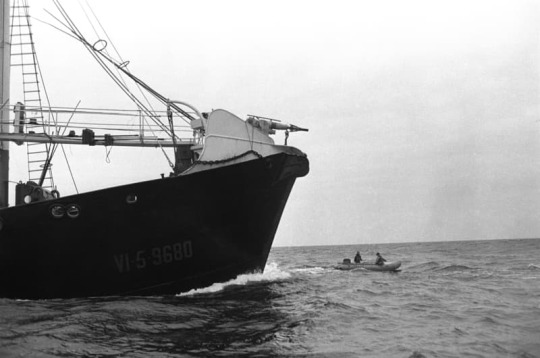
Tras una búsqueda infructuosa por las costas de Corcubión, donde se encontraba una de las estaciones balleneras. El Warrior volvió de nuevo hacia Vigo, donde la tripulación avistó un ballenero, el Ibsa III. En un instante, las Zodiacs neumáticas estaban en el agua y maniobrando en torno al barco.
Greenpeace logró impedir las capturas tan eficazmente, que apareció para interrumpir la protesta la corbeta Cadarso, a la que pronto se unió la Pinzón, con órdenes de detener al Warrior. Una vez precintado el cuarto de radio, el Warrior fue conducido a la base naval de El Ferrol bajo escolta armada. Decididas a no dejarlo escapar, las autoridades españolas organizaron un servicio de guardia de 24 horas y desmontaron un componente esencial del sistema de propulsión: la mitad superior de la chumacera que sujeta el árbol de la hélice. También sometieron a custodia al patrón Jon Castle, al que más tarde acusan de interferir con la labor de las empresas pesqueras españolas.
Durante cinco meses, el Warrior permaneció bajo custodia. Los tripulantes podían bajar a tierra siempre que permanecieran dentro de los límites de la ciudad, oportunidad que solían aprovechar para granjearse el apoyo de la opinión pública mediante mítines y proyecciones de diapositivas. Se ataron al barco arrestado pancartas en las que se leía: «Libertad para el Rainbow Warrior. Los visitantes se agolpaban en la sala de exposiciones del barco.
Por fin llegaron las piezas para reparar la lancha rápida RI-28. Una vez reparada, Bruce Crammond, Chris Robinson y Athel von Koettlitz partieron en ella hacia el golfo de Vizcaya; tras una carrera de 500 millas (800 km), alcanzaron las islas del Canal, pero avería en el motor les impidió llegar a la reunión de 1980 de la IWC. que se celebraba en Brighton, en la costa sur de Inglaterra. donde esperaban comunicar al mundo las actividades ilícitas de captura de ballenas que se realizaban en España.
A lo largo de los años, los grupos de presión política de Greenpeace habían logrado abrirse camino en la IWC, que ya no era un simple frente unido de balleneros. En esta reunión, la comisión redujo las cuotas de captura en un 13 por ciento y por primera vez. sometió a las orcas al sistema de cuotas. Se dieron los primeros pasos para prohibir el llamado arpón frío (que no lleva explosivo, y con frecuencia mutila en lugar de matar) para todas las ballenas salvo el rorcual aliblanco, ya que, según los balleneros, destruía una proporción excesiva de la carne. La votación a favor de una moratoria de 10 años en la captura comercial de ballenas se perdió por un margen muy reducido.
Para Greenpeace las noticias eran excelentes, pero para mantener vivo el espíritu de la campaña contra los balleneros era preciso rescatar sin demora al Rainbow Warrior. Casi todos los tripulantes habían salido de España, aunque John Castle se vio obligado a permanecer allí. Para liberar el buque, las autoridades españolas exigían a Greenpeace el pago de 10 millones de pesetas para compensar a la empresa ballenera por las pérdidas que había sufrido; Greenpeace tenía abogados que llevaban el caso ante los tribunales españoles, pero la lentitud del procedimiento era exasperante. Como no había forma de encontrar una chumacera de segunda mano para el Warrior, Greenpeace obtuvo los planos originales del barco, y una pequeña empresa mecánica de Inglaterra fabricó la pieza que faltaba. Tony Marriner y el jefe de máquinas del Warrior. Tim Mark, condujeron hasta El Ferrol con la pieza de 68 kg. y una noche oscura lograron introducirla a bordo burlando la vigilancia de la policía mientras los tripulantes distraen su atención.
La pieza vital se montó con muy ligeros ajustes, pero lo principal era saber si funciona. En el curso de una prueba subrepticia del motor principal funcionó con suavidad, pero la verdadera prueba tendría que superarla navegando. Aún quedaba por solucionar otra dificultad; tras cinco meses de amarre, el casco del Warrior estaba calurosa bienvenida en Jersey. En España, el suceso costó el puesto a un almirante y valió a Greenpeace una mayor popularidad, que terminó en la apertura de una oficina en el país. El Warrior era ahora una celebridad. Pronto se prepara para su primera travesía del Atlántico, con el fin de unirse a la protesta contra la caza de focas planeada para la primavera de 1981.
Ocupó su puesto en Europa el Sirius, vendido a Greenpeace Países Bajos por el gobierno holandés, simpatizante de la organización, a cambio de tan solo 20.000 florines, de los que aportó una parte considerable la rama holandesa de la World Wildlife Fund.
Construido en los Países Bajos en 1950 como parte de un grupo de siete buques piloto para la Real Marina Holandesa, el Sirius tiene 46 metros, desplaza 440 toneladas y alcanza una velocidad máxima de 13 nudos: dispone de autonomía para 30 días de navegación con una tripulación de 32 personas. Después de la compra, la organización disponía de sólo 10 semanas para dejarlo listo para su primera campaña.
Greenpeace estaba ya firmemente asentada, no sólo en los Países Bajos, sino también en Dinamarca, donde empezó a operar en Copenhague con ayuda de una donación de 5.000 dólares de Greenpeace International.
Ese año, ocho activistas daneses y holandeses entraron en acción contra la participación noruega en la caza de focas. Noruega era el principal cazador de focas de casco en el Atlántico Norte, ya que desde 1945 había acabado con el 85 por ciento de una población de 1.5 millones de individuos.
Los activistas abordaron al barco cazador Kvitungen en Alesund, se encadenaron a él y enarbolaron sus pancartas. Las fotografías de la protesta se difundieron ampliamente y generaron abundante apoyo al grupo danés.
También en la República Federal de Alemania estaba creciendo el apoyo a Greenpeace, que abrió allí su primera oficina en febrero de 1981. Uno de los primeros miembros fue Gerd Leipold, oceanógrafo y físico del instituto Max Planck. «Estaba convencido de que ser científico no bastaba para cambiar las cosas» , comenta.
También hay que destacar a Monika Griefahn, que seguía las campañas balleneras de Greenpeace desde 1978. En 1980 conoció en Francia a Remi Parmentier y David MeTaggart y. con su ayuda, se estableció Greenpeace Alemania.
En unos meses se les unieron más de 3.000 miembros, atraídos por acciones tan espectaculares como la escalada de Greenpeace del 24 de junio de 1981. Participaron dos escaladores, que treparon por la contaminante chimenea de una fábrica de plaguicidas de Hamburgo y colgaron una pancarta que decía: «Cuando se corte el último árbol, se mate al último pez y se envenene el último río, os encontraréis con que no podéis comeros el dinero.
Fue una buena ración para los alemanes, habitantes de un país fuertemente industrializado cuyos bosques enferman ante los ataques de la lluvia ácida. La opinión pública estaba particularmente preocupada por informes según los cuales había compuestos tóxicos en las reservas de agua y en la leche materna de las mujeres.
El diseñador y coordinador de las acciones en Alemania era Harald Zindler, amigo de Griefahn y participante activo en las protestas antinucleares de los años setenta. También había trabajado con pescadores, preocupados por la calidad de las aguas del Elba. en el que los peces empezaban a desarrollar feos tumores a consecuencia de la contaminación. En una de las primeras acciones. Se arrojaron peces deformes a la puerta del Instituto Hidrográfico Alemán, organismo público teóricamente encargado de controlar la contaminación del agua.
Originally published at https://cuidarelplaneta.com/ August 09, 2023.
#Activismo Ambiental#Balleneros#Caza de Focas#Conciencia Ecológica#Greenpeace#Protección del Medio Ambiente
0 notes
Text
Rust Belt Jessie’s NaPoWriMo 2023 Prompts: #31
lyric questions
Here we are—lucky number 31! I put an extra one in here in case you’re doing a 31/31, or in case you’re doing a 30/30 and felt like skipping one of the other exercises. I’m also putting this in, once again, as much for me as for you.
In Chen Chen’s book, Your Emergency Contact Has Experienced an Emergency (which you should really read, if you haven’t yet), many of the sections are comprised of responses to Bhanu Kapil’s twelve questions, from her book The Vertical Interrogation of Strangers. These twelve questions are unusual, and Chen Chen’s responses to them are in-depth, surreal and so-real, heartbreaking and lovely. In fact, he lays out here his approach to this exercise. (Or at least, how he suggests others might approach it.)
I decided a while ago that I wanted to attempt something similar, but with different questions. And then I saw this—the security questions from the California Franchise Tax Board website. And I knew I had found my questions.
And then just the other day, I saw prompt #12 on the NaPoWriMo 2023 prompts list from Carolee Bennett/Good Universe Next Door:
Time to channel your inner Indigo Girls! Well, sort of. Brainstorm a list of questions (or borrow some from questionnaires or quizzes) and write a poem that offers truly odd answers to “regular”/”normal” questions.
So, for this exercise, you can go one of two ways: you can offer unusual answers to ‘regular’ questions, or you can offer in-depth answers to more unusual questions. You can brainstorm your own questions (usual or un-), use Bhanu Kapil’s questions, use the California Franchise Tax Board security questions, or look up other security questions or questions from quizzes or questionnaires. You can write your responses in prose-poem form, a la Chen Chen, or in a more verse-like form (a la the recommended poem from Good Universe Next Door, “Interview Before Taking His Name,” by Jill Crammond). It’s up to you.
All you have to do is ask.
Then, answer.
(This exercise is from my ebook of NaPoWriMo prompts, which can be found here.)
#napowrimo#glopowrimo#writing prompts#poetry#lyric questions#lyric poetry#questions#napowrimo 2023#jessie lynn mcmains
1 note
·
View note
Text
0 notes
Photo

#photography#original photographers#photographers on tumblr#beach#crammond#edinburgh#path#blue#pale#hipster#art#aesthetic#grunge#vintage#faded#follow4follow#follow back
20 notes
·
View notes
Photo


#fashion#portrait#scotland#scottish#edinburgh#crammond#beach#sea#water#ocean#darja bilyk#photography#walk#fashionable#runway#clothes#model#pose#short#hair#glasses#seagul#bird#shadow#story#explore#photoshoot
1 note
·
View note
Video
youtube
Gremlins 3: Dawn of Desmond - A “film” by Nick Lutsko and Justin Cipriani
#movie#trailer#gremlins#nick lutsko#justin cipriani#mikey fuller#tim heidecker#doug lussenhop#vic berger#matt honkonen#brielle garcia#clair lutsko#grayson honkonen#landon linton#jarius bush#scott crammond
9 notes
·
View notes
Text



Crammond Island Anchorage August 11, 2022
3 notes
·
View notes